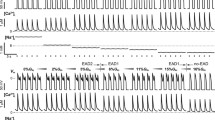Abstract.
Cyclic bursts of ventricular premature contractions (VPC) coming at minute-order intervals have been discerned by analyzing ambulatory ECG recordings, and their mechanism has not been clarified. The present study simulates this phenomenon by constructing a bidirectional modulated parasystole model. With Ts and Te as the intrinsic periods of the sinus and ectopic pacemakers, there are distinct and initial condition-dependent solutions in the model with Ts/Te values close to 1, 1/2, 1/4, etc. Typically, two distinct stable solutions are found existing together around Ts/Te = 1/2. We have verified theoretically the coexistence of different solutions and their dependence on the model parameters. The solution presented switches between those by a premature stimulus and those by fluctuations in the model parameters such as Ts. Patterns of RR intervals were generated by simulation with randomly fluctuating Ts. They included cyclic bursts of bigeminy of the “flat type” and the “dome type” reported by Takayanagi et al. (1999) and other transient types with Wenckebach or reverse Wenckebach rhythm of coupling intervals. This model provides a mathematical representation of the atrioventricular feedback mechanism and enables the modulated parasystole hypothesis to be applied to wider classes of VPCs.
Similar content being viewed by others
References
Abramovich-Sivans S, Akselrod S (1998) A pacemaker cell pair model based on the phase response curve. Biol Cybern 79:77–86
Castellanos A, Alatriste VM, Sung RJ, Sheps DS, Myerburg RJ (1980) A search for modulation in intermittent ventricular parasystole. Pace 3:73–83
Courtemanche M, Glass L, Rosengarten MD, Goldberger AL (1989) Beyond pure parasystole:promises and problems in modeling complex arrhythmias. Am J Physiol 257:H693–H706
Glass L, Goldberger AL, Belair J (1986) Dynamics of pure parasystole. Am J Physiol 251:H841–H847
Ikeda N (1982) Model of bidirectional interaction between myocardial pacemakers based on the phase response curve. Biol Cybern 43:157–167
Ikeda N, Tsuruta H, Sato T (1981) Difference equation model of the entrainment of myocardial pacemaker cells based on the phase response curve. Biol Cybern 42:117–128
Ikeda N, Yoshizawa S, Sato T (1983) Difference equation model of a ventricular parasystole as an interaction between cardiac pacemakers based on the phase response curve. J Theor Biol 103:439–465
Ikeda N, DeLand EC, Miyahara H, Takeuchi A, Yamamoto H, Sato T (1988) A personal computer-based arrhythmia generator based on mathematical models of cardiac arrhythmia. J Electrocardiol 21:S122–S128
Ikeda N, Takayanagi K, Takeuchi A, Nara Y, Miyahara H (1997) Arrhythmia curve interpretation using a dynamic system model of the myocardial pacemaker. Meth Inform Med 36:286–289
Jalife J, Moe GK (1976) Effect of electrotonic potentials on pacemaker activity of canine Purkinje fibers in relation to parasystole. Circ Res 39:801–808
Jalife J, Moe GK (1979) Phasic effects of vagal stimulation on pacemaker activity of the isolated sinus node of the young cat. Circ Res 45:595–607
Jalife J, Hamilton AJ, Lamanna VR, Moe GK (1980) Effects of current flow on pacemaker activity of the isolated kitten sinoatrial node. Am J Physiol 238:H307–H316
Jalife J, Michaels DC, Delmar M (1988) Cellular mechanisms of phasic vagal control of heart rate. In: Neurocardiology. Futura, New York, p 99
Keener JP (1980) Chaotic behavior in piecewise continuous difference equations. Trans Am Math Soc 26:589–604
Kinoshita S (1974) Wenckebach phenomenon of entrance block in intermittent ventricular parasystole. Chest 66:530–535
Levy MN, Mori I, Kerin N (1977) Two variants of concealed trigeminy. Am Heart J 93:183–188
Moe GK, Jalife J, Muller WJ, Moe B (1977) A mathematical model of parasystole and its application to clinical arrhythmias. Circulation 56:968–979
Sano T, Sawanobori T, Adaniya H (1978) Mechanism of rhythm determination among pacemaker cells of the mammalian sinus node. Am J Physiol 235:H379–H384
Schamroth L, Marriott HJL (1961) Intermittent ventricular parasystole with observations on its relationship to extrasystolic bigeminy. Am J Cardiol 7:799–809
Schamroth L (1971) The disorder of cardiac rhythm, vols I and II . Blackwell, Oxford
Takayanagi K, Kamishirado H, Iwasaki Y, Fujito T, Inoue T, Hayashi T, Morooka S (1999) Cyclic bursts of ventricular premature contractions of more than one minutes intervals. Jpn Heart J 40:135–144
Takayanagi K, Tanaka K, Kamishirado H, Sakai Y, Fujito T, Inoue T, Hayashi T, Morooka S, Ikeda N (2000) Direct discrimination and full-day disclosure of ventricular parasystole on new heart rate tachograms. J Cardiovasc Electrophysiol 11:168–177
Yoshizawa S, Osada Y, Nagumo J (1982) Pulse sequences generated by a degenerate analog neuron model. Biol Cybern 45:23–33
Author information
Authors and Affiliations
Corresponding author
Rights and permissions
About this article
Cite this article
Ikeda, N., Takeuchi, A., Hamada, A. et al. Model of bidirectional modulated parasystole as a mechanism for cyclic bursts of ventricular premature contractions. Biol. Cybern. 91, 37–47 (2004). https://doi.org/10.1007/s00422-004-0496-0
Received:
Accepted:
Published:
Issue Date:
DOI: https://doi.org/10.1007/s00422-004-0496-0




